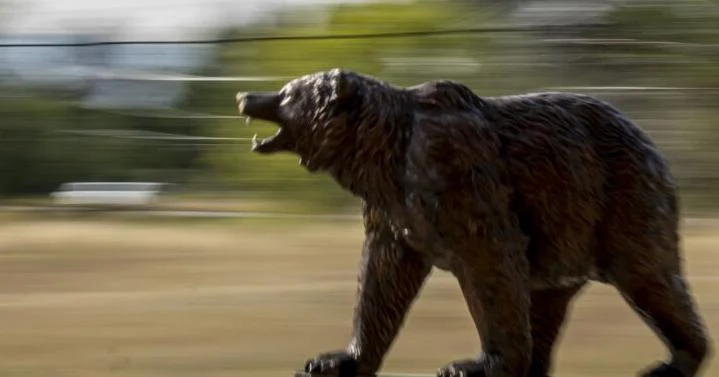
Whether it’s bugs, berries, roots, grasses, mushrooms, rodents or big game, learning about nearly any piece of the ecosystems in the Northern Rockies will eventually lead you to a better understanding of bears.
With 288 known species of plants, animals and fungi on their menu (and counting), grizzly bears have a diet as varied as the forests, meadows and grasslands they call home, according to Danielle Oyler, a wildlife stewardship specialist with Montana Fish, Wildlife & Parks.
“It just depends on what’s ripe, what’s available at that time of year,” Oyler said. “So that’s my plug for your naturalist muscles, learning about your plant and animal communities. The better you understand the natural environment, the better you can understand how bears are using it.”
Oyler, who is based in Bozeman, was speaking to a room full of locals at FWP’s regional office in Missoula in early September, which the agency has designated as “Bear Aware Month.”
Drawing some spectators was the spectacle of a “robotic bear” capable of charging 35 mph — as fast as a horse at full gallop, and also as fast as a grizzly at full gallop.
In a real bear encounter, regardless of how the bear is acting, Oyler said, “If you feel like you’re in danger, just use your bear spray. At 25 or 30 feet, if you’re that close, just use your bear spray.”
Paired with the robot — actually a plastic statue of a grizzly mounted on a large remote-controlled, wheeled platform — were boxes of inert bear spray to test participants’ skills at halting a would-be bear attack.
Two at a time, participants were given a canister each and stood with their backs turned to the charging robot. At the shout of “bear!” they turned, flicked off the safety and fired a cloud of aerosol at the bear. The proper technique involves shooting it at a 45-degree angle toward the ground in front of the bear.
And while some prefer a large-caliber handgun as a backup, both weapons should be seen as a last resort. Oyler urged people to hone their knowledge and awareness of bears and their behavior before heading into their territory.
“Avoiding conflict is easier than dealing with conflict,” she said.
That means recognizing that bears have a sense of smell seven times sharper than domestic dogs, and treating potential food sources accordingly. Oyler noted that bears can even be attracted to unopened canned food, or sealed plastic packages of food, meaning campers need to put all their cooking supplies in a bear hang, a bear canister or a locked vehicle (with the windows up).
People who live in places where bears are moving around should also secure attractants in their yards, including bird feeders, barbecues, coolers (even if there’s no food left), dog food and fruit trees.
Oyler noted that at this time of year, bears become hungrier as they bulk up for the winter, known as “hyperphagia.” They can eat for up to 20 hours a day while consuming as many as 20,000 calories.
Listen now and subscribe: Apple Podcasts | Google Podcasts | Spotify | RSS Feed | Montana Untamed
“So imagine if that was your job, was to get that many calories, do you think you could go out in the forests around Missoula and get 20,000 calories in one day?” she asked. “What if you just walked past the neighborhood that has some bird feeders?”
FWP’s Missoula-based bear specialist Jamie Jonkel added that even a green lawn can attract bears in late summer.
“This time of year, when it’s dry as a bone, if you heavily water your lawn it’s like an oasis,” Jonkel said. “The deer, everything, including the bears, will come to eat the grass.”
Behavior versus species
Despite the myths, Oyler said bears’ sense of hearing and sight is comparable to ours. That means making a lot of noise on the trail is a must, especially for those hiking or recreating alone. Studies of bear movements have shown that bears will typically move off the trail if they hear people coming, then wait until they’re gone before going back to what they were doing.
“They actively respond to the sound of people,” Oyler said.
Keeping alert to recent signs of bears — tracks, scat, bear rubs, dug-up ground or torn-up rotted logs — can reduce the odds of an encounter. But if that happens, Oyler said, bear experts have recently begun teaching people to react based on the bear’s behavior, rather than assuming how it will act based on its species.
While black bears are fundamentally different than grizzlies in many ways, both species exhibit distinct behaviors if they’re acting defensively versus predatory.
A defensive bear might be surprised, or is protecting its cubs or a source of food. They’ll tend to act aggressive and stressed, Oyler said, making noise, panting, slamming its feet on the ground or even bluff charging. The correct response is to act calm, stand your ground while slowly backing away, and use bear spray if necessary.
A predatory bear, on the other hand, will seem calmer.
“If you see a bear that is curious, calm, interested (or) following, yell at it,” she said. “Be aggressive. Use your bear spray. You want that bear to know, ‘It’s not worth your time. Don’t mess with me.’”
In either case, she said, never run away from a bear. And never “play dead” if the bear is acting predatory.
Oyler summarized: “If the bear is upset, you’re acting calm. If the bear is acting calm and creepy, you get upset.”
A possible third category, Jonkel added, might be called the “complacent” bear, which largely ignores the humans in its environment.
“In order to eat the chokecherries around the Kim Williams Trail, they have to ignore the 57 people on bikes and the 150 people on foot that are hiking,” Jonkel said, referring to the popular trail between the University of Montana campus and Clark Fork River in Missoula.
“To most of the bears around Missoula here, we’re like cattle. We’re everywhere on the landscape. And in order for them to use the habitat, they have to develop this complacency around us.”
Sam Wilson is the outdoors and environment reporter at the Missoulian.
You must be logged in to react.
Click any reaction to login.
Love
0
Funny
0
Wow
0
Sad
0
Angry
0
Be the first to know
Get local news delivered to your inbox!
* I understand and agree that registration on or use of this site constitutes agreement to its user agreement and privacy policy.
Sam Wilson
Outdoors and Environment Reporter
Get email notifications on {{subject}} daily!
Your notification has been saved.
There was a problem saving your notification.
{{description}}
Email notifications are only sent once a day, and only if there are new matching items.
Followed notifications
Please log in to use this feature
Log In
Don’t have an account? Sign Up Today



